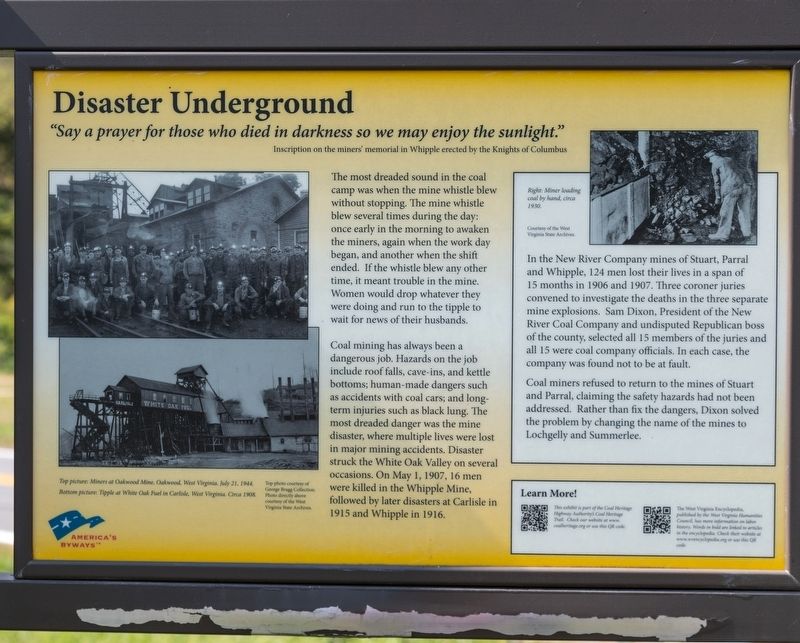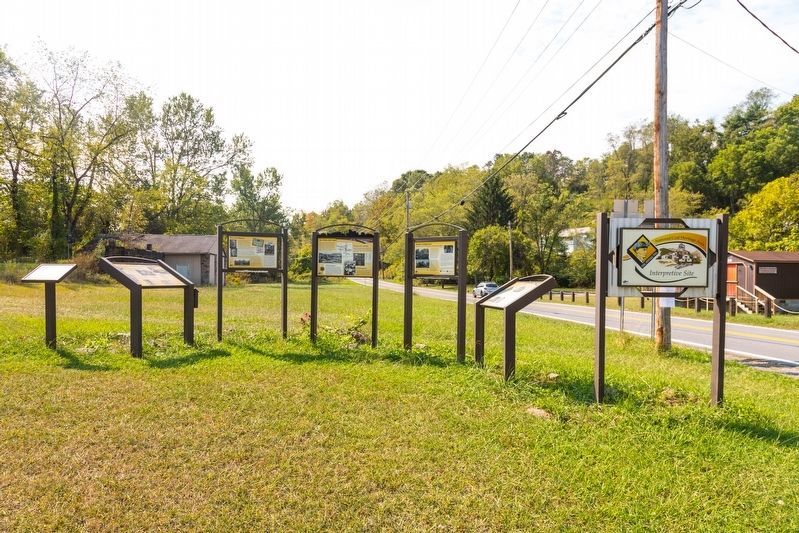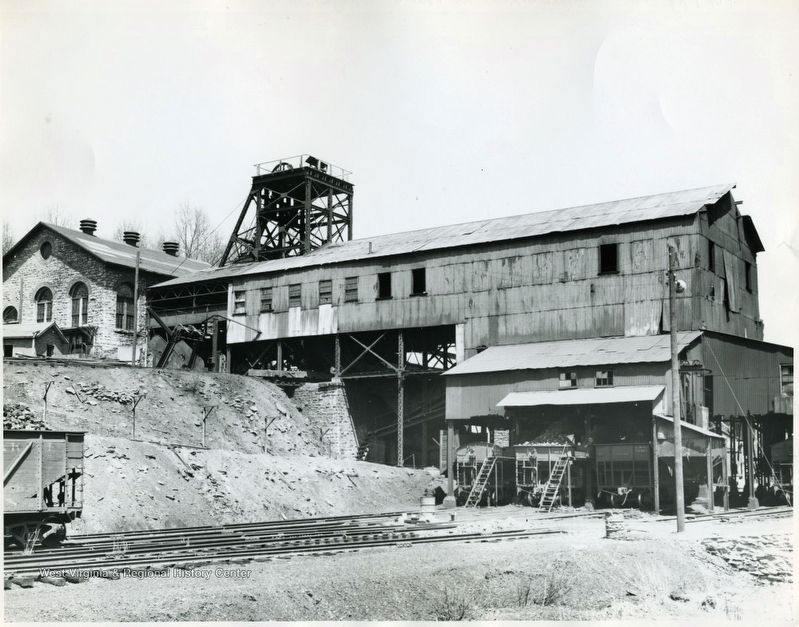Whipple Junction in Fayette County, West Virginia — The American South (Appalachia)
Disaster Underground
— Coal Heritage Trail — National Coal Heritage Area Interpretive Site —
The most dreaded sound in the coal camp was when the mine whistle blew without stopping. The mine whistle blew several times during the day: once early in the morning to awaken the miners, again when the work day began, and another when the shift ended. If the whistle blew any other time, it meant trouble in the mine. Women would drop whatever they were doing and run to the tipple to wait for news of their husbands.
Coal mining has always been a dangerous job. Hazards on the job include roof falls, cave-ins, and kettle bottoms; human-made dangers such as accidents with coal cars; and long-term injuries such as black lung. The most dreaded danger was the mine disaster, where multiple lives were lost in major mining accidents. Disaster struck the White Oak Valley on several occasions. On May 1, 1907, 16 men were killed in the Whipple Mine, followed by later disasters at Carlisle in 1915 and Whipple in 1916.
In the New River Company mines of Stuart, Parral and Whipple, 124 men lost their lives in a span of 15 months in 1906 and 1907. Three coroner juries convened to investigate the deaths in the three separate mine explosions. Sam Dixon, President of the New River Coal Company and undisputed Republican boss of the county, selected all 15 members of the juries and all 15 were coal company officials. In each case, the company was found not to be at fault.
Coal miners refused to return to the mines of Stuart and Parral, claiming the safety hazards had not been addressed. Rather than fix the dangers, Dixon solved the problem by changing the name of the mines to Lochgelly and Summerlee.
Topics. This historical marker is listed in these topic lists: Disasters • Industry & Commerce • Labor Unions • Natural Resources. A significant historical date for this entry is May 1, 1907.
Location. 37° 57.506′ N, 81° 9.947′ W. Marker is in Whipple Junction, West Virginia, in Fayette County. Marker is at the intersection of Okey L Patterson Road (West Virginia Route 612) and Scarbro Road (Route 1/5), on the right on Okey L Patterson Road. It is across from the Whipple Company Store and Museum. Touch for map. Marker is at or near this postal address: 7485 Okey L Patteson Rd, Scarbro WV 25917, United States of America. Touch for directions.
Other nearby markers. At least 8 other markers are within 2 miles of this marker, measured as the crow flies. Labor Strikes and Conflicts (here, next to this marker); The Coal Barons (here, next to this marker); Community Life in a Coal Camp (here, next to this marker); The White Oak Valley
(here, next to this marker); Hank Williams Memorial (approx. 1.2 miles away); Hank Williams — The Last Ride (approx. 1.4 miles away); Oakwood Mine Complex (approx. 1.4 miles away); Oak Hill Railroad Depot (approx. 1.6 miles away). Touch for a list and map of all markers in Whipple Junction.
More about this marker. This interpretive panel has shows three photographs. Upper left: Miners at Oakwood Mine, Oakwood West Virginia. July 21, 1944” Below: “Tipple at White Oak Fuel in Carlisle, West Virginia. Circa 1908.” Upper right: “Miner loading coal by hand, circa 1930.”
Additional commentary.
1. Dreadful Explosion in Whipple Coal Mine
Article in The Piqua Daily Call (Ohio) May 2, 1910.
Hinton, W. Va., May 2. — Sixty-one men are believed to have lost their lives as the result of an explosion in the Whipple mine at Scarboro, Wednesday afternoon.
Eighty-one men were working in the mine at the time of the explosion, the cause of which has not been learned. All but 61 escaped.
Many of those who managed to escape were seriously injured. Among those entombed is Isaac Pelter, mine boss, who remained behind, endeavoring to close the air courses and force fresh air into the chambers where the other men were caught.
The only others whose names are known are: Edward Smith, Erastus Willey, Arnold Kelley, Charles Burgess, Hud Burgess, Raleigh Tucker
Edward Melton, G. W. Temper, all white.
A telephone message just received from Scarboro says that at 7 o’clock a rescuing party was able to enter the mine and at 10 o’clock 51 bodies had been recovered.
Of those, about half were still alive but all were burned and blackened in a horrible manner. The work of rescue was still going forward, but the percentage of the dead increased with each minute.
The fumes in the mine are steadily overcoming the crippled survivors of the first shock. It is believed that the list will go above sixty.
The explosion occurred at a time when the full complement of miners was under the earth. The cause of the explosion has not yet been ascertained, but fire damp is suspected.
The Whipple mine lies about four miles from the Parral mine, in which the great explosion occurred a year ago and still nearer the Stuart mine, in which almost a hundred miners perished in the month of February.
An attempt was being made to connect by tunnel the Whipple and Stuart shafts, and it is suspected that this work was, in a measure responsible for the explosion.
The mine is the property of the syndicate headed by Samuel Dixon, the Fayette coal king, and is considered one of the most valuable properties in the Fayette district.
The location of the mine is remote from telegraphic communication and the only telephone line reaching the place is under control of the mining company, hence it has been found impossible to secure details.
The miners were, for the most part Hungarians, with a few negroes and native whites.
— Submitted September 30, 2019, by J. J. Prats of Powell, Ohio.
Credits. This page was last revised on October 2, 2019. It was originally submitted on September 30, 2019, by J. J. Prats of Powell, Ohio. This page has been viewed 412 times since then and 146 times this year. Photos: 1. submitted on September 30, 2019, by J. J. Prats of Powell, Ohio. 2. submitted on September 26, 2019, by J. J. Prats of Powell, Ohio. 3. submitted on September 30, 2019, by J. J. Prats of Powell, Ohio.


